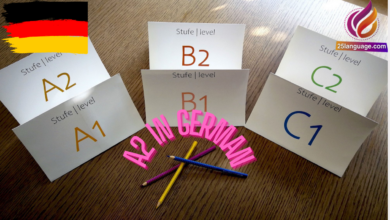German Articles

German Articles. German grammar is simple! But often it’s explained in a complicated way. If you don’t believe me, I’ll show you!
What are Articles? (Artikel)
In English, there are three articles: “a,” “an,” and “the.” They tell you if we are talking about, for example, a specific tree (“the tree”) or an unspecified tree (“a tree”). With “a” and “an,” we have to use a different one depending on the beginning sound of the noun (“a tree” vs. “an apple”).
In German, we are going to extend this a bit.
First, we include more things under the category “German Articles.”
The different types of articles
- Definite and Indefinite Articles (Bestimmte und unbestimmte Artikel = a/an)
- the Zero Article (Nullartikel = No Article)
- Possessive Determiners (Possesivartikeln – my, your,..)
- the Negative Article (Negativartikel – “no” as article)
Articles come before nouns and help you understand what exactly we’re talking about. They are also declined (change their form) to give you information about the noun’s…
- Gender: der = masculine; die = feminine; das = neuter
- Number: Singular or Plural
- Case: Nominative, Accusative, Dative, Genitive
The German Definite Article (Bestimmte Artikel)
In English, the definite article is “the”:
- der – „der Vater“
- die – „die Mutter“
- das – „das Kind“
Using The German Definite Article
Definite articles are used when talking about something specific.
⇒ The noun is unique. You can say exactly what you are talking about.
- „Der Hund holt die Zeitung.“ (This specific dog got this specific newspaper)
Definite articles are used when talking about something generally known or already specifically mentioned.
- „Das Eis ist kalt.“ (Everyone knows what „Eis“ is)
- „Das ist der Mann, den ich gestern getroffen habe.“ (It’s a specific man, not just anyone)
Declining German Definite Articles

The German Indefinite Article (Unbestimmte Artikel)
In English, “a” and “an” are indefinite articles:
- ein – „ein Mann“ (masculine)
- ein – „ein Kind“ (neuter)
- eine – „eine Frau“ (feminine)
Using German Indefinite Articles
Indefinite articles are used when we talk about something unspecified.
⇒ The noun is not unique. It is one of many.
- „Der Hund holt einen Stock.”
(There are many sticks. It could be any of them.)
Declining German Indefinite Articles

Recommendation: Sometimes do not use an Article
With the Indefinite Article in the Plural, you leave out the Article. This is the Zero Article. In which other situations you also have to remove the Article, I will explain in the lesson: The Zero Article.
Articles with Prepositions (Artikel mit Präpositionen)
In some instances, German definite articles combined with a Prepositions:
- an + das = ans „Ich fahre ans Meer.“
- an + dem = am „Am Montag gehe ich…“
- in + das = ins „Ich springe ins Wasser.“
- in + dem = im „Ich bin im Kino.“
- zu + der = zur „Ich gehe zur Arbeit.“
- zu + dem = zum „Ich gehe zum Kino.“
- bei + dem = beim „Ich bin beim Bahnhof.“
- von + dem = vom „Ich komme vom Mars.“
These pairs are always combined.
If you say it separately, everyone will still understand you, but there is a difference in meaning: the noun is really emphasized (like the English “this,” which is a Demonstrative Pronoun).
Examples
- „Eine Frau fährt zur Arbeit.“
(It could be ANY woman // zur = zu der ⇒ not any job, HER job.) - „Die Frau fährt mit einem Fahrrad zur Arbeit.
(A specific woman that the speaker and listener know, but any bicycle.)
And then you can master German with Learning German application.





























